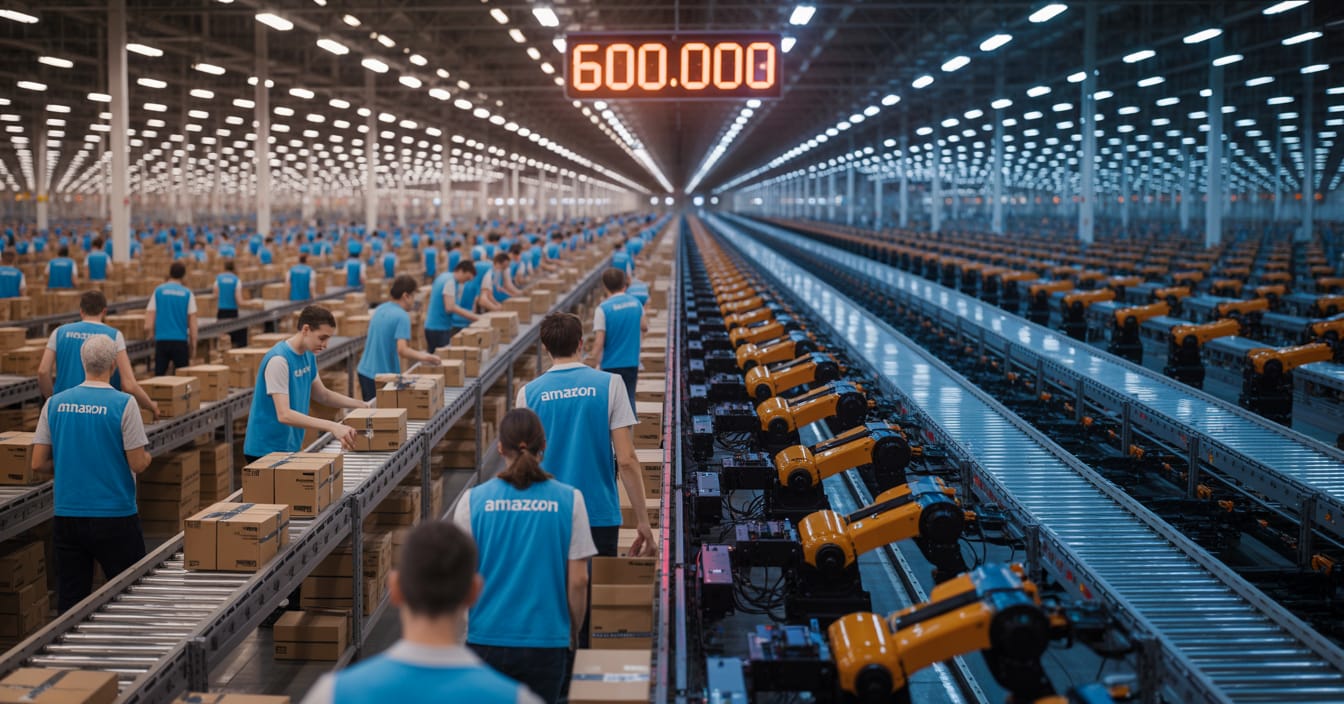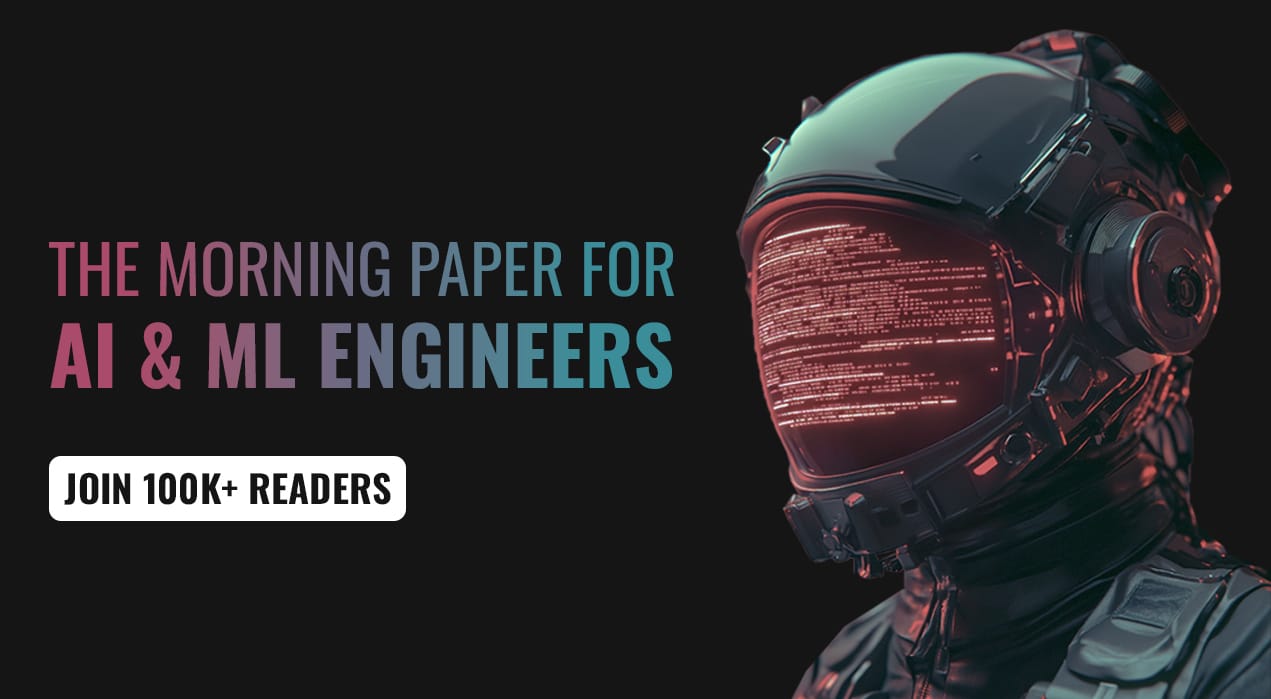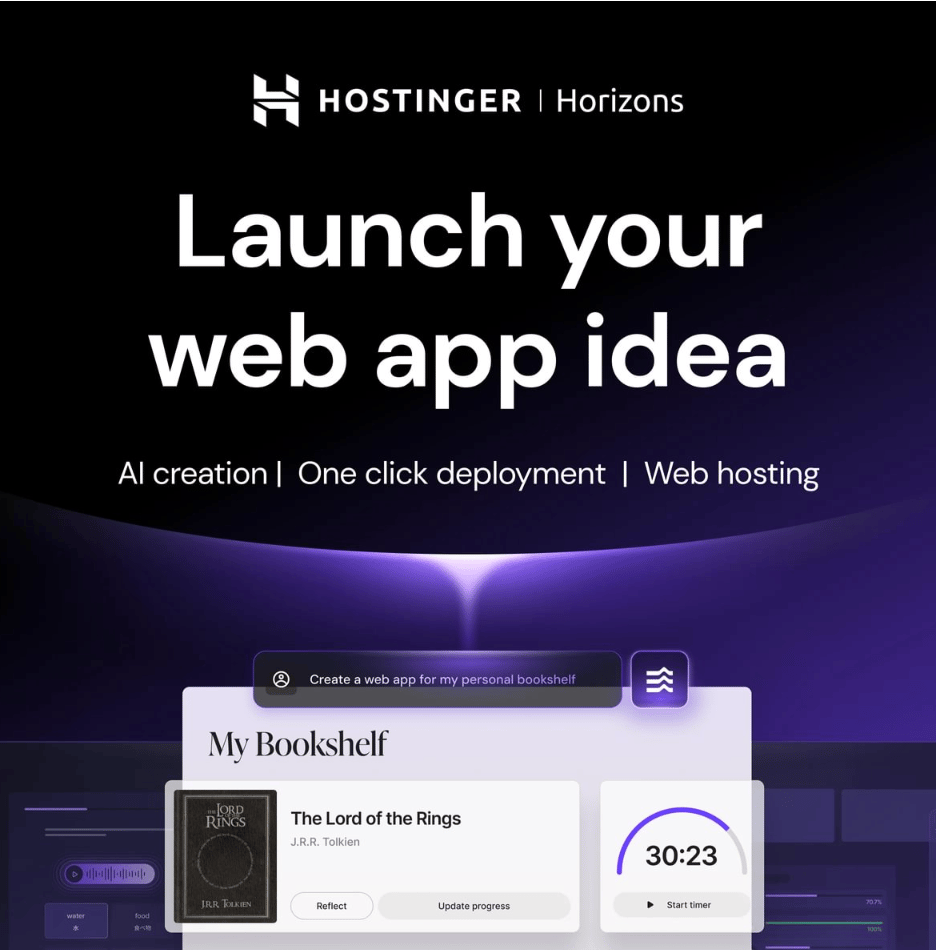Tech moves fast, but you're still playing catch-up?
That's exactly why 100K+ engineers working at Google, Meta, and Apple read The Code twice a week.
Here's what you get:
Curated tech news that shapes your career - Filtered from thousands of sources so you know what's coming 6 months early.
Practical resources you can use immediately - Real tutorials and tools that solve actual engineering problems.
Research papers and insights decoded - We break down complex tech so you understand what matters.
All delivered twice a week in just 2 short emails.
Beginners in AI
Thank you for joining us again!
Welcome to this week's edition of Beginners in AI, where we explore the latest trends, tools, and news in the world of AI and the tech that surrounds it. Like all editions, this is human curated, and published with the intention of making AI news and technology more accessible to everyone.
Amazon's internal documents revealed plans to replace more than 600,000 workers with robots by automating 75 percent of operations. This week also brought Coinbase's Payments MCP enabling AI agents to handle crypto autonomously, Anthropic's Claude Memory expanding to all paid users, and OpenAI's ChatGPT Atlas browser challenging Google Chrome. Inside: analysis of automation reaching manufacturing and logistics simultaneously, how physical AI is transitioning from controlled demonstrations to full workday autonomy, the financial implications of AI gaining economic agency, and what these parallel developments signal for the future of human employment across industries.
AI PULSE CHECK
Market Temperature: 🔥 Hot
This Week's Vital Signs:
Capital Flow: Microsoft commits $80B for AI infrastructure in fiscal 2025 (↑ 60% from previous year)
Biggest Check: OpenAI securing multi-billion dollar AMD partnership for GPU access
Talent Migration: Amazon's robotics team expanding while planning workforce reduction through attrition
M&A Activity: Amazon's $4B investment in Anthropic solidifies AWS as exclusive cloud provider
Stock Response: Alphabet shares down 2% on Atlas announcement; robotics stocks up 12% average
Unicorn Watch: ChatGPT hits 800M weekly active users; Amazon's robot workforce exceeds 1M units
The Diagnosis: The second-largest U.S. employer planning to "flatten its hiring curve" while doubling sales represents fundamental restructuring of labor economics.
Week Ahead: Watch for Amazon automation milestones, potential labor union organizing efforts, and other major manufacturers announcing humanoid deployment plans.
AI TOP STORY
Leaked Amazon Documents Reveal Plan to Replace 600,000 Workers with Robots

What happened: Internal Amazon documents leaked to The New York Times on October 21, 2025, revealed the company's strategic plan to replace more than 600,000 jobs with robots while automating 75 percent of its operations—a move projected to save 30 cents per item processed and delivered. Amazon's robot workforce already exceeds one million units, approaching parity with its 1.56 million human employees, and the company's Shreveport, Louisiana warehouse serves as the blueprint where packages move through the system with minimal human contact, operating with 25 percent fewer workers than traditional facilities. The leaked strategy documents show Amazon planning to slow hiring "to a crawl" even as sales double by 2033, using attrition to reduce workforces at facilities like Stone Mountain where up to 1,200 jobs could be eliminated. By 2027, the Shreveport model will expand to 40 Amazon facilities nationwide.
The documents also revealed Amazon's awareness of public perception risks, instructing teams to avoid terms like "automation" and "AI" in favor of sanitized language like "advanced technology" and "cobot" (collaborative robot). The company planned community outreach including parade participation and Toys for Tots drives to maintain a "good corporate citizen" image in areas where jobs would be eliminated.
Why it matters: This represents a fundamental shift in how America's second-largest private employer approaches its workforce. While Amazon claims automation creates "higher paying jobs," the leaked documents tell a different story—a deliberate strategy to reduce human employment even as business grows. The robotics team wrote in its 2025 strategy: "With this major milestone now in sight, we are confident in our ability to flatten Amazon's hiring curve over the next 10 years."
The implications extend far beyond Amazon. If the company successfully proves the economics of mass automation in manual labor—saving 30 cents per item across billions of packages—competitors will face enormous pressure to follow suit. Walmart, Target, UPS, and FedEx all operate similar fulfillment and distribution networks. The automation technology Amazon is deploying isn't proprietary; it's commercially available from companies like Agility Robotics, Boston Dynamics, and others.
What to take away: For workers in logistics, warehousing, and distribution, this is a warning signal. Amazon isn't alone—it's just the first to have its plans leak publicly. The economics driving this decision (30 cents saved per item) create irresistible pressure for competitors to automate or lose market share. For consumers, this raises questions about the social contract: should we support companies that systematically eliminate human jobs while growing profits? And for policymakers, Amazon's strategy demands urgent attention to retraining programs, safety nets, and likely even regulations around automation's pace and scale. The future of work isn't coming—it's here, and it looks like a warehouse with very few people in it.
LAST WEEK IN AI AND TECH
Anthropic's Claude Gets Memory, Finally Catches Up to ChatGPT
Anthropic expanded Claude's automatic memory feature to all Pro and Max subscribers on October 23, 2025, allowing the chatbot to retain preferences, project details, and conversation context across sessions without constant repetition. The feature includes project-specific memory spaces, ensuring work details stay separate from creative projects, and users can view, edit, or delete memories at any time. Max subscribers gained immediate access while Pro users will receive the feature over the coming days.
"We're building toward Claude understanding your complete work context and adapting automatically," said Mike Krieger, Anthropic's chief product officer.
OpenAI Launches ChatGPT Atlas Browser to Challenge Google
OpenAI released ChatGPT Atlas on October 21, 2025—a Chromium-based web browser with ChatGPT integration built into every page through an "Ask ChatGPT" sidebar. The browser launched on macOS with 800 million weekly ChatGPT users as its potential audience, offering agent mode for Plus and Pro subscribers that can autonomously book reservations, order groceries, and complete web forms. Atlas includes browser memory to personalize responses over time and positions OpenAI as a direct competitor to Google Chrome's 3 billion users.
"A browser built with ChatGPT takes us closer to a true super-assistant that understands your world and helps you achieve your goals," said OpenAI CEO Sam Altman.
Google Earth AI Adds Gemini for Disaster Response and Climate Monitoring
Google announced major updates to Earth AI on October 23, 2025, introducing a Geospatial Reasoning framework powered by Gemini that automatically connects weather forecasts, population maps, and satellite imagery to answer complex questions. The system helped identify 15 million people at risk during California's 2025 wildfires and is now being used by WHO AFRO to predict cholera outbreaks in Democratic Republic of Congo. Google AI Pro and Ultra subscribers gained immediate access to Gemini capabilities in Google Earth with higher usage limits.
"Earth AI is built on decades modeling the world, combined with state of the art predictive models and Gemini's advanced reasoning, letting enterprises, cities and nonprofits achieve deeper understanding in minutes—efforts that previously required complex analytics and years of research," noted Chris Phillips, VP & GM, Geo, and Yossi Matias, VP & GM, Google Research.
Coinbase Launches Payments MCP, Giving AI Agents Cryptocurrency Wallets
Coinbase launched Payments MCP (Model Context Protocol) on October 22, 2025, enabling AI agents to autonomously create cryptocurrency wallets, add funds, and execute stablecoin transactions through natural language commands. The system works with Claude, Gemini, and Codex, requiring only an email address for setup with no API keys needed, while users configure spending limits and permissions through a graphical interface. The protocol builds on Coinbase's x402 standard, developed with Cloudflare, allowing AI agents to pay for compute resources, access paywalled data, or manage business operations.
"Crypto rails—and stablecoins in particular—are the ideal payment infrastructure for agentic commerce," said Erik Reppel, Coinbase's head of engineering for its developer platform. "They move at the speed of code, integrate seamlessly with APIs, and enable autonomous agents to act without human friction."
Meta Announces AI Will Shape Your Feed Starting December
Meta announced on October 7, 2025 that starting December 16, conversations with Meta AI will be used to personalize content and ads across Facebook and Instagram for over 1 billion monthly Meta AI users. If users ask Meta AI about hiking boots or recipe ideas, they'll see more related posts, Reels, groups, and advertisements—though sensitive topics like politics, health, and religion are excluded from this personalization. The policy won't apply in EU, UK, or South Korea at launch due to stricter privacy regulations, and the only way to avoid this is to not use Meta AI features.
Meta provided no specific executive quote for this policy announcement, which appeared as an update to their data usage policies.
The Human Benchmark: Weekly Comparison
How We're Measuring Up:
ARC-AGI Progress: 41% → 42% (human baseline: 85%)
Cost to Replace Human Hour:
Warehouse Labor: $18.50 → $4.80 (↓ 74% with robotic automation at scale)
Manufacturing Assembly: $28.00 → $9.20 (↓ 67% with humanoid robots working 8-hour shifts)
Customer Service: $12.20 → $11.80 (↓ 3%)
Coding: $45.00 → $42.00 (↓ 7%)
New Human Parity Reached: Web navigation tasks (OpenAI Atlas matches human browser efficiency)
Biggest Gap Remaining: Adaptability to completely novel situations—humans remain vastly superior at handling unprecedented problems without retraining
Expert Assessment: "The cost calculation has shifted decisively in favor of automation for repetitive physical tasks. When robots can work full shifts without supervision at one-third the cost, human labor becomes economically indefensible at industrial scale," - Dr. Daron Acemoglu, MIT Economics Professor, 2024 Nobel Prize Winner
Once they work out how to do this profitably, it will spread to others, too. One of the biggest employers in the United States will become a net job destroyer, not a net job creator.
TECH TERMS TO KNOW
Cobot (Collaborative Robot) - Amazon's preferred term for robots, designed to suggest human-robot collaboration rather than replacement
TOOL SPOTLIGHT (non-sponsored)
Hostinger started as a web hosting company and naturally progressed to AI web app building, that can host what you build.
ROBOTICS AND AI
Carbon Robotics Raises $20M for Secret Farm Robot
Seattle agriculture-tech startup Carbon Robotics raised $20 million in new funding to support the creation of another piece of AI-powered machinery for farms. The company's founder and CEO Paul Mikesell told GeekWire that a brand new AI robot is coming, though it remains at least nine months away from being revealed. With its signature LaserWeeder and relatively new Autonomous Tractor Kit already being used by hundreds of customers, Carbon plans this machine to leverage the same AI system used in its other equipment but perform tasks beyond weeding. The LaserWeeder G2, released in February, uses an array of AI, computer vision and machine learning technology to detect plants in fields and then target and eliminate weeds with lasers.
"It's very flexible, capable of doing a lot with the world around it, understanding what it's seeing, what's happening," said Paul Mikesell, Carbon Robotics CEO and founder.
AGI Progress Report
Week's Proximity Movement: 4.2/10 → 4.6/10 (↑ 0.4 points)
Why the Score Changed:
Physical AI systems demonstrating economic viability at massive scale (1M+ robots in single company)
AI agents gaining autonomous financial capabilities via Coinbase MCP
Combination of physical robotics and cognitive AI reaching practical deployment threshold
This Week's Capabilities: ✅ AI Can Now:
Operate autonomously in complex warehouse environments at commercial scale
Replace human workers at 25% lower staffing levels while maintaining productivity
Create and manage cryptocurrency wallets autonomously
Execute financial transactions without human approval (within set limits)
Maintain persistent memory across sessions for personalized experiences
❌ Still Can't:
Handle unexpected warehouse situations requiring human judgment
Adapt to entirely new tasks without retraining
Understand long-term societal consequences of mass automation
Demonstrate empathy or ethical reasoning about job displacement
Self-improve capabilities without extensive human engineering
The Week's Big Signal: Amazon's 600,000-job automation plan represent the most significant physical AI milestone of 2025. When humanoid robots can work full manufacturing shifts and warehouse systems can replace three-quarters of human workers, we're witnessing AGI's physical manifestation reaching economic breakeven.
TRY THIS PROMPT (copy and paste into ChatGPT, Grok, Perplexity, Gemini)
You are a career evolution strategist. I need you to analyze my current job role and help me understand the automation impact.
My current role: [Insert your job title and 2-3 main responsibilities]
Please provide:
1. **Automation Risk Assessment** (0-100% scale)
- Which specific tasks in my role are most likely to be automated in the next 3 years
- Which tasks will remain uniquely human
- Overall automation risk score with explanation
2. **Future Role Evolution**
- How my job will likely transform rather than disappear
- New responsibilities that will emerge
- Skills that will become more valuable
3. **90-Day Action Plan**
- 3 specific skills I should start developing now
- Concrete learning resources for each skill
- How to demonstrate these new capabilities to my employer
4. **AI Collaboration Strategy**
- Which AI tools I should learn to use in my current role
- How to position myself as an "AI-augmented" professional
- Specific ways to increase my productivity using AI
Format your response as a clear, actionable roadmap. Be honest about risks but focus on adaptation strategies.Career Future-Proofing: Generate a personalized analysis of how AI automation might affect your specific job role and create a skill development plan
What this does: Creates a personalized career adaptation plan based on this week's automation news, giving you specific actions to stay relevant as AI transforms the workforce. Takes 3-5 minutes to complete and generates a practical roadmap you can start implementing immediately.
DID YOU KNOW?
Amazon's Alexa was almost named "Amazon" but engineers discovered the word caused too many false activations. "Alexa" was chosen because the "X" sound is rare in casual conversation and the name pays homage to the ancient Library of Alexandria.
Meanwhile, Siri got its name because it means "beautiful woman who leads you to victory" in Norwegian.
30 Referrals: Lifetime access to all Beginners in AI videos and courses
AI-ASSISTED IMAGE OF THE WEEK

imagined by caden_butera
The Prompt: sci-fi thriller movie poster called Recollection about deleting memories, blue and gray color pallet, brown-haired woman in center, low-key lighting
Interested in stock trading, but no clue where to start? Sign-up for our sister newsletter re-launching soon. Each day will build onto the next using current news as a learning aid.
Thank you for reading. We’re all beginners in something. With that in mind, your questions and feedback are always welcome and I read every single email!
-James
By the way, this is the link if you liked the content and want to share with a friend.






